A Novel Dual-Band (38/60 GHz) Patch Antenna for 5G Mobile Handsets
Abstract
:1. Introduction
2. The Proposed Dual-Band Microstrip Patch Antenna
3. Simulations and Results
3.1. Development of the Dual-Band Microstrip Patch antenna Design
3.2. Parametric Study for the Selection of the Optimal Parameters of the Dual-Band Patch Antenna
3.2.1. Effect of the Parasitic Patch Width
3.2.2. Effect of the Inset Length
3.3. Optimal Design of the Dual-Band Microstrip Patch Antenna
3.4. Dual-Band Patch Antenna Fabrication and Experimental Assessment
3.4.1. Fabrication of the Antenna Prototype
3.4.2. Measurements of the Return Loss
3.4.3. Measurement of the Radiation Patterns and Maximum Gain
3.5. Performance Comparison with Published Work
4. Conclusions
Author Contributions
Funding
Conflicts of Interest
References
- Jilani, S.F.; Alomainy, A. Millimetre-wave T-shaped MIMO antenna with defected ground structures for 5G cellular networks. IET Microw. Antennas Propag. 2018, 12, 672–677. [Google Scholar] [CrossRef]
- Diawuo, H.A.; Jung, Y.B. Broadband proximity-coupled microstrip planar antenna array for 5G cellular applications. IEEE Antennas Wirel. Propag. Lett. 2018, 17, 1286–1290. [Google Scholar] [CrossRef]
- Das, G.; Sharma, A.; Gangwar, R.K.; Sharawi, M.S. Performance improvement of multiband MIMO dielectric resonator antenna system with a partially reflecting surface. IEEE Antennas Wirel. Propag. Lett. 2019, 18, 2105–2109. [Google Scholar] [CrossRef]
- Lu, D.; Wang, L.; Du, Y.; Wu, X.; Wang, G. Compact dual-band bow-tie MIMO antennas with fragment-type isolation structure. In Proceedings of the 12th European Conference on Antennas and Propagation, London, UK, 9–13 April 2018; pp. 761–764. [Google Scholar]
- Abdullah, M.; Kiani, S.H.; Abdulrazak, L.F.; Iqbal, A.; Bashir, M.A.; Khan, S.; Kim, S. High-performance multiple-input multiple-output antenna system for 5G mobile terminals. Electronics 2019, 8, 1090. [Google Scholar] [CrossRef] [Green Version]
- Youcheng, W.; Yanjiao, Y.; Qingxi, C.; Hucheng, P. Design of a compact ultra-wideband MIMO antenna. J. Eng. 2019, 2019, 6487–6489. [Google Scholar] [CrossRef]
- Muhammad, S.; Yaro, A.S.; Ya’u, I.; Salawudeen, A.T. Design of 5G mobile millimeter wave antenna. ATBU J. Sci. Technol. Educ. 2019, 7, 178–184. [Google Scholar]
- Ojaroudi Parchin, N.; Jahanbakhsh Basherlou, H.; Alibakhshikenari, M.; Ojaroudi Parchin, Y.; Al-Yasir, Y.I.; Abd-Alhameed, R.A.; Limiti, E. Mobile-phone antenna array with diamond-ring slot elements for 5G massive MIMO systems. Electronics 2019, 8, 521. [Google Scholar] [CrossRef] [Green Version]
- Sa’don, S.N.; Jamaluddin, M.H.; Kamarudin, M.R.; Ahmad, F.; Yamada, Y.; Kamardin, K.; Idris, I.H. Analysis of graphene antenna properties for 5G applications. Sensors 2019, 19, 4835. [Google Scholar] [CrossRef] [Green Version]
- Ikram, M.; Nguyen-Trong, N.; Abbosh, A. Multiband MIMO microwave and millimeter antenna system employing dual-function tapered slot structure. IEEE Trans. Antennas Propag. 2019, 67, 5705–5710. [Google Scholar] [CrossRef]
- Li, Y.; Luo, Y.; Yang, G. Multiband 10-antenna array for sub-6 GHz MIMO applications in 5-G smartphones. IEEE Access 2018, 6, 28041–28053. [Google Scholar] [CrossRef]
- Chen, C.M.; Volski, V.; Van der Perre, L.; Vandenbosch, G.A.; Pollin, S. Finite large antenna arrays for massive MIMO: Characterization and system impact. IEEE Trans. Antennas Propag. 2017, 65, 6712–6720. [Google Scholar] [CrossRef]
- Ojaroudi Parchin, N.; Jahanbakhsh Basherlou, H.; Al-Yasir, Y.I.; Abdulkhaleq, A.M.; Patwary, M.; Abd-Alhameed, R.A. A new CPW-Fed diversity antenna for MIMO 5G smartphones. Electronics 2020, 9, 261. [Google Scholar] [CrossRef] [Green Version]
- Yang, B.; Yu, Z.; Dong, Y.; Zhou, J.; Hong, W. Compact tapered slot antenna array for 5G millimeter-wave massive MIMO systems. IEEE Trans. Antennas Propag. 2017, 65, 6721–6727. [Google Scholar] [CrossRef]
- Khalid, M.; Iffat Naqvi, S.; Hussain, N.; Rahman, M.; Mirjavadi, S.S.; Khan, M.J.; Amin, Y. 4-Port MIMO antenna with defected ground structure for 5G millimeter wave applications. Electronics 2020, 9, 71. [Google Scholar] [CrossRef] [Green Version]
- Layegh, M.A.; Ghobadi, C.; Nourinia, J.; Samoodi, Y.; Mashhadi, S.N. Adaptive Neuro-Fuzzy Inference System approach in bandwidth and mutual coupling analyses of a novel UWB MIMO antenna with notch bands applicable for massive MIMOs. Aeu-Int. J. Electron. Commun. 2018, 94, 407–417. [Google Scholar] [CrossRef]
- Zhang, S.; Zhinong, Y. MIMO Antennas for Mobile Terminals. Available online: https://scholar.google.com/scholar?cluster=16108449328272360019&hl=zh-CN&as_sdt=0,5 (accessed on 20 April 2020).
- Marzouk, H.M.; Ahmed, M.I.; Shaalan, A.E. Novel dual-band 28/38 GHz MIMO antennas for 5G mobile applications. Prog. Electromagn. Res. 2019, 93, 103–117. [Google Scholar] [CrossRef] [Green Version]
- Luo, X.S.; Weng, Z.B.; Zhang, W.J.; Yang, L. Compact planar multiband MIMO antenna based on composite right/left-handed transmission line for mobile phone applications. Microw. Opt. Technol. Lett. 2018, 60, 1505–1511. [Google Scholar] [CrossRef]
- Niu, B.J.; Tan, J.H. Compact SIW cavity MIMO antenna with enhanced bandwidth and high isolation. Electron. Lett. 2019, 55, 631–632. [Google Scholar] [CrossRef]
- Thummaluru, S.R.; Kumar, R. Chaudhary RK.Isolation and frequency reconfigurable compact MIMO antenna for wireless local area network applications. IET Microw. Antennas Propag. 2019, 13, 519–525. [Google Scholar] [CrossRef]
- Abirami, M. A review of patch antenna design for 5G. In Proceedings of the 2017 IEEE International Conference on Electrical, Instrumentation and Communication Engineering (ICEICE), Karur, India, 27–28 April 2017; IEEE: Piscataway, NJ, USA, 2017; pp. 1–3. [Google Scholar]
- Khan, J.; Sehrai, D.A.; Ali, U. Design of dual band 5G antenna array with SAR analysis for future mobile handsets. J. Electr. Eng. Technol. 2019, 14, 809–816. [Google Scholar] [CrossRef]
- Dzagbletey, P.A.; Jung, Y.B. Stacked microstrip linear array for millimeter-wave 5G baseband communication. IEEE Antennas Wirel. Propag. Lett. 2018, 17, 780–783. [Google Scholar] [CrossRef]
- Rachakonda, A.; Bang, P.; Mudiganti, J. A compact dual band MIMO PIFA for 5G applications. Mater. Sci. Eng. Conf. Ser. 2017, 263, 052034. [Google Scholar] [CrossRef]
- Haraz, O.M. Broadband and 28/38-GHz dual-band printed monopole/elliptical slot ring antennas for the future 5G cellular communications. J. InfraredMillim. Terahertz Waves 2016, 37, 308–317. [Google Scholar] [CrossRef]
- Şeker, C.; Güneşer, M.T. A single band antenna design for future millimeter wave wireless communication at 38 GHz. Eur. J. Eng. Form. Sci. 2018, 2, 35–39. [Google Scholar]
- Hong, W.; Baek, K.H.; Ko, S. Millimeter-wave 5G antennas for smartphones: Overview and experimental demonstration. IEEE Trans. Antennas Propag. 2017, 65, 6250–6261. [Google Scholar] [CrossRef]
- Wani, Z.; Abegaonkar, M.P.; Koul, S.K. A 28-GHz antenna for 5G MIMO applications. Prog. Electromagn. Res. 2018, 78, 73–79. [Google Scholar] [CrossRef] [Green Version]
- Saini, J.; Agarwal, S.K. Design a single band microstrip patch antenna at 60 GHz millimeter wave for 5G application. In Proceedings of the 2017 international conference on Computer, Communications and Electronics (Comptelix), Jaipur, India, 1–2 July 2017; IEEE: Piscataway, NJ, USA, 2017; pp. 227–230. [Google Scholar]
- Saad, A.A.; Mohamed, H.A. Printed millimeter-wave MIMO-based slot antenna arrays for 5G networks. AEU-Int. J. Electron. Commun. 2019, 99, 59–69. [Google Scholar] [CrossRef]
- Imran, D.; Farooqi, M.M.; Khattak, M.I.; Ullah, Z.; Khan, M.I.; Khattak, M.A.; Dar, H. Millimeter wave microstrip patch antenna for 5G mobile communication. In Proceedings of the 2018 International Conference on Engineering and Emerging Technologies (ICEET), Lahore, Pakistan, 22–23 February 2018; IEEE: Piscataway, NJ, USA, 2018; pp. 1–6. [Google Scholar]
- Dadgarpour, A.; Sorkherizi, M.S.; Kishk, A.A. High-efficient circularly polarized magnetoelectric dipole antenna for 5G applications using dual-polarized split-ring resonator lens. IEEE Trans. Antennas Propag. 2017, 65, 4263–4267. [Google Scholar] [CrossRef]
- Lin, H.S.; Lin, Y.C. Millimeter-wave MIMO antennas with polarization and pattern diversity for 5G mobile communications: The corner design. In Proceedings of the 2017 IEEE International Symposium on Antennas and Propagation & USNC/URSI National Radio Science Meeting, San Diego, CA, USA, 9–14 July 2017; IEEE: Piscataway, NJ, USA, 2017; pp. 2577–2578. [Google Scholar]
- Cabrol, P.; Pietraski, P. 60 GHz patch antenna array on low cost Liquid-Crystal Polymer (LCP) substrate. In Proceedings of the IEEE Long Island Systems, Applications and Technology (LISAT) Conference 2014, Farmingdale, NY, USA, 2 May 2014; IEEE: Piscataway, NJ, USA, 2014; pp. 1–6. [Google Scholar]
- Zhang, G.; Pu, S.; Xu, X.; Liu, Y.; Wang, C. Design of 60-GHz microstrip antenna array composed through circular contour feeding line. In Proceedings of the 2016 Asia-Pacific International Symposium on Electromagnetic Compatibility (APEMC), Shenzhen, China, 17–21 May 2016; IEEE: Piscataway, NJ, USA, 2016; Volume 1, pp. 1010–1013. [Google Scholar]

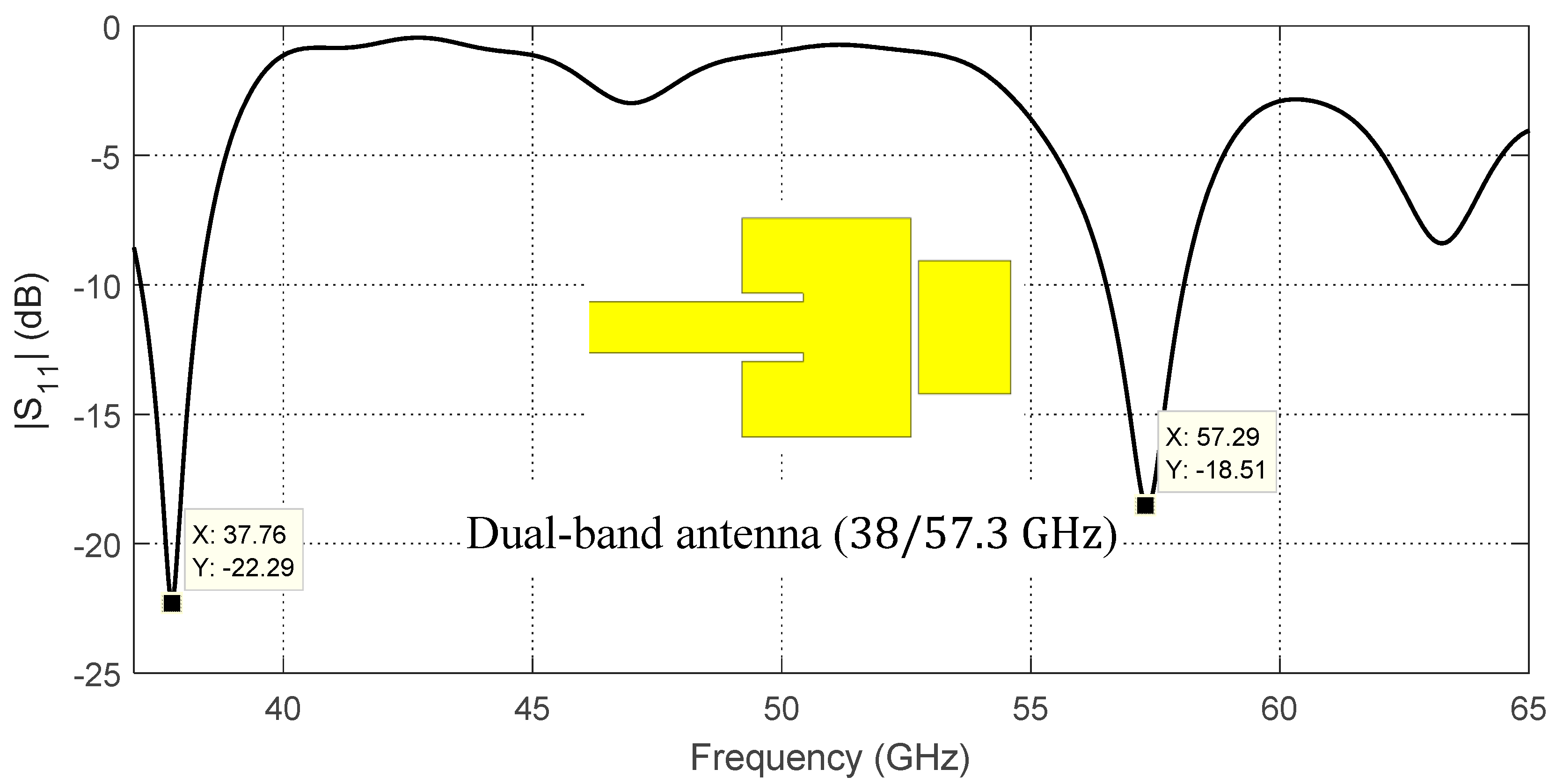
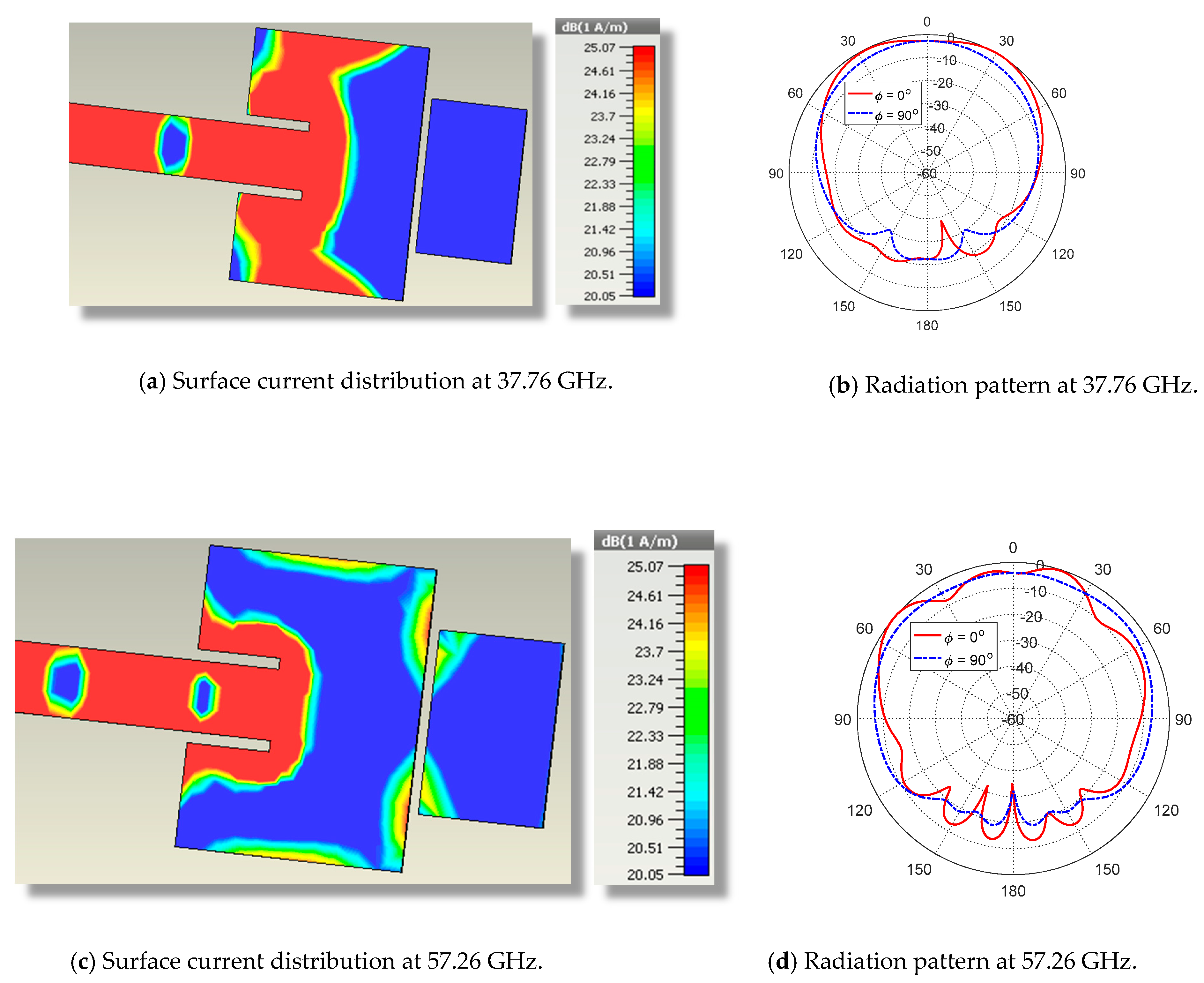




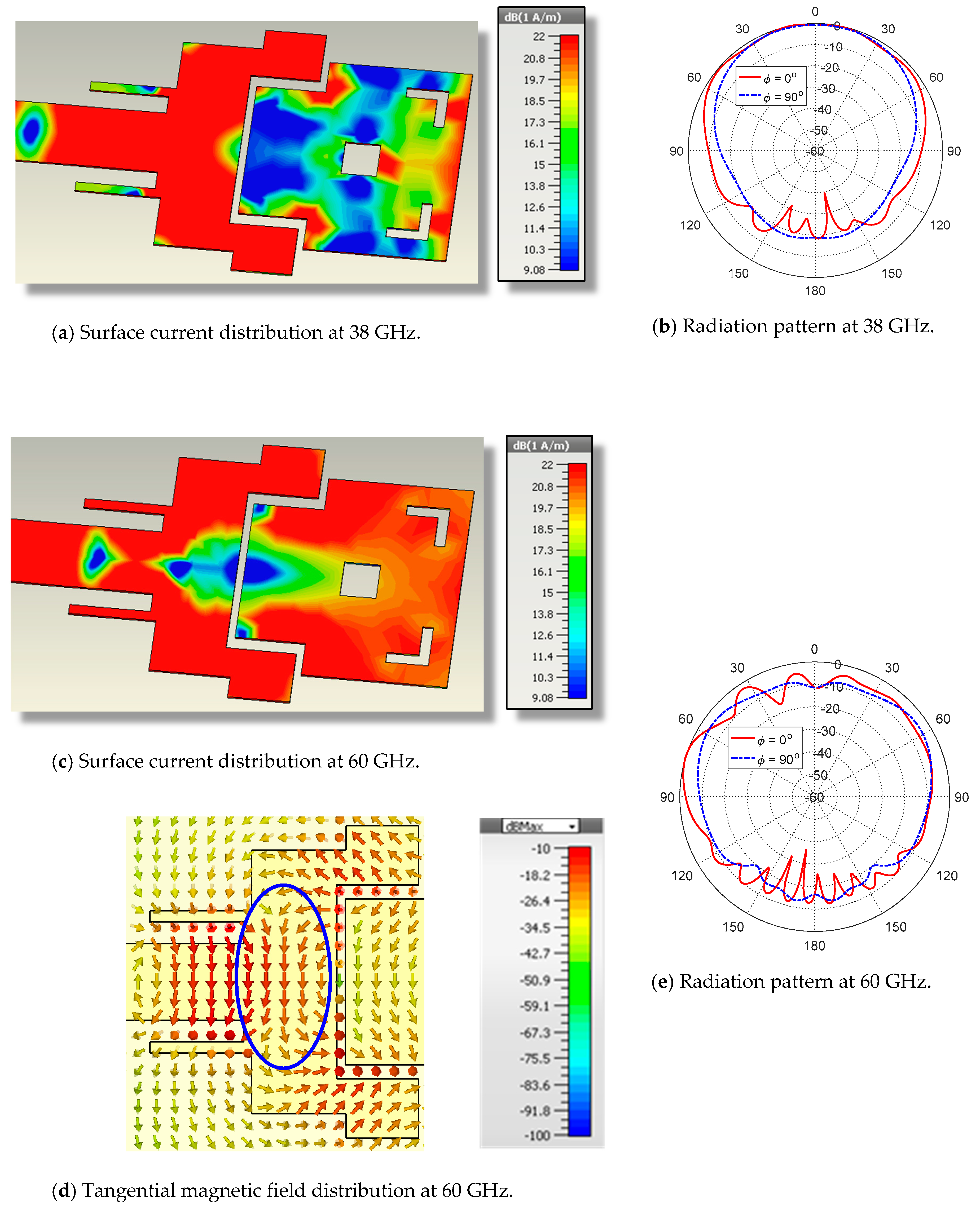





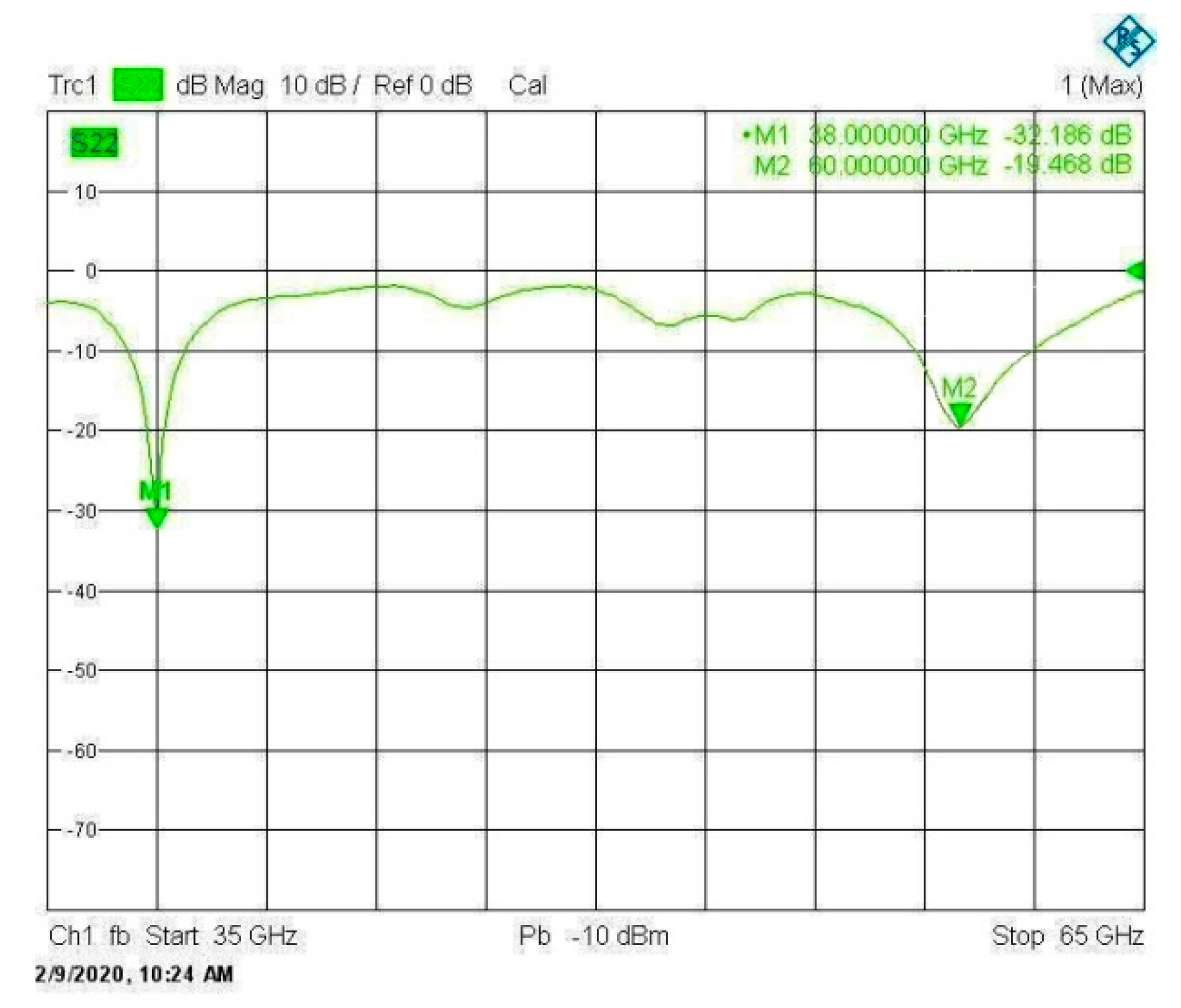

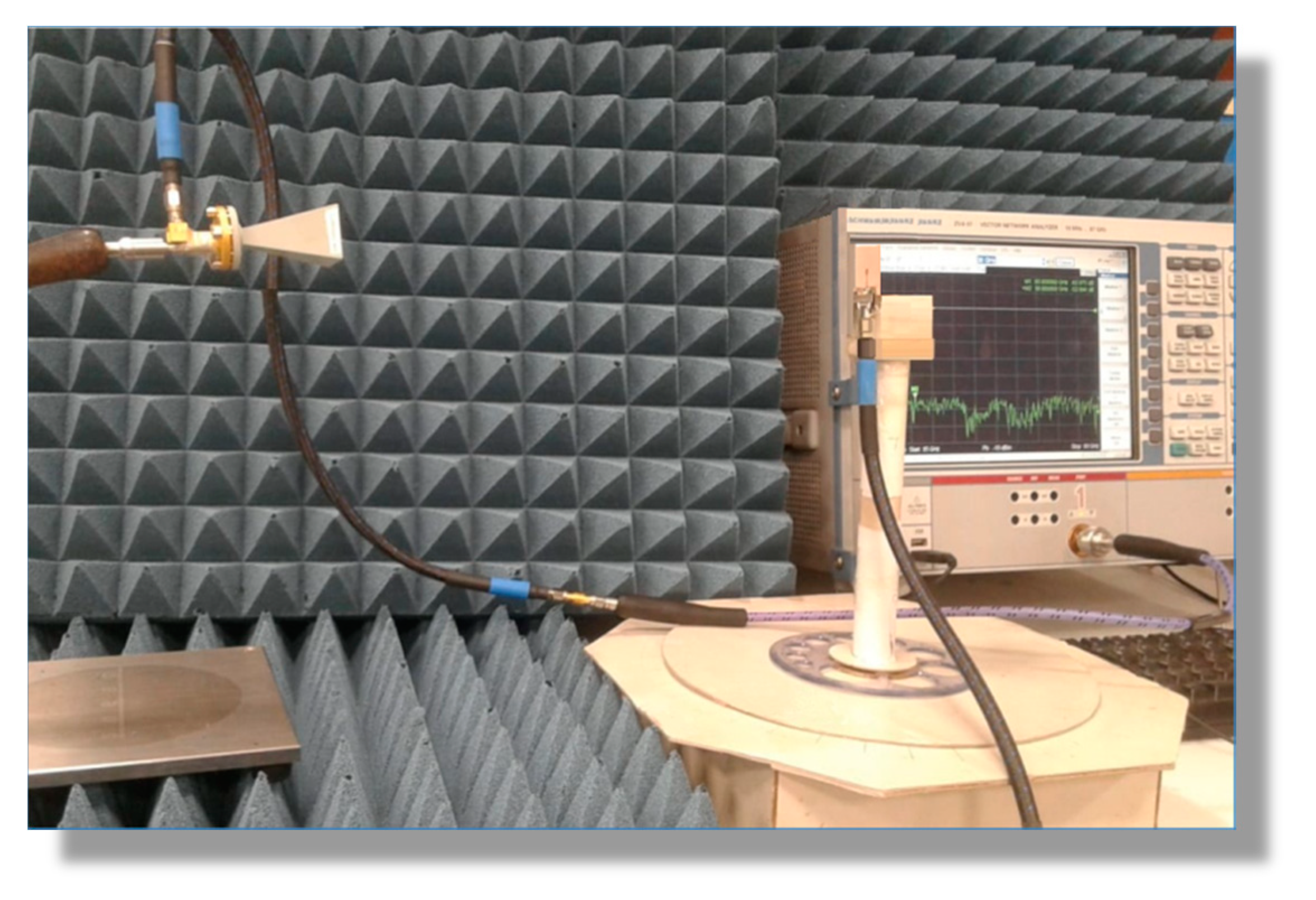




| Dimension | |||||||
|---|---|---|---|---|---|---|---|
| Value (mm) | 2.165 | 1.22 | 2.57 | 1.36 | 0.66 | 0.76 | 0.18 |
| Frequency | ||
|---|---|---|
| Total Efficiency | ||
| Radiation Efficiency | ||
| Performance Measure | |||||||
|---|---|---|---|---|---|---|---|
| Present Work | Work of [32] | Work of [23] | Present Work | Work of [35] | Work of [36] | ||
| Center Frequency | 38.0 | 38.3 | 37.0 | 60.5 | 60.3 | 60.1 | |
| BW | 1.0 | 3.3 | 0.9 | 0.35 | |||
| 0.45 | 1.85 | 0.5 | 0.2 | ||||
| 0.07 | 0.8 | 0 | 0.02 | ||||
| Patch area (mm2) | Array only | ||||||
| Patch Gain (dBi) | 6.5 | 7.4 | 7.7 | 5.5 | 6.2 | NA | |
© 2020 by the authors. Licensee MDPI, Basel, Switzerland. This article is an open access article distributed under the terms and conditions of the Creative Commons Attribution (CC BY) license (http://creativecommons.org/licenses/by/4.0/).
Share and Cite
Sharaf, M.H.; Zaki, A.I.; Hamad, R.K.; Omar, M.M.M. A Novel Dual-Band (38/60 GHz) Patch Antenna for 5G Mobile Handsets. Sensors 2020, 20, 2541. https://doi.org/10.3390/s20092541
Sharaf MH, Zaki AI, Hamad RK, Omar MMM. A Novel Dual-Band (38/60 GHz) Patch Antenna for 5G Mobile Handsets. Sensors. 2020; 20(9):2541. https://doi.org/10.3390/s20092541
Chicago/Turabian StyleSharaf, Marwa H., Amira I. Zaki, Radwa K. Hamad, and Mohamed M. M. Omar. 2020. "A Novel Dual-Band (38/60 GHz) Patch Antenna for 5G Mobile Handsets" Sensors 20, no. 9: 2541. https://doi.org/10.3390/s20092541
APA StyleSharaf, M. H., Zaki, A. I., Hamad, R. K., & Omar, M. M. M. (2020). A Novel Dual-Band (38/60 GHz) Patch Antenna for 5G Mobile Handsets. Sensors, 20(9), 2541. https://doi.org/10.3390/s20092541





